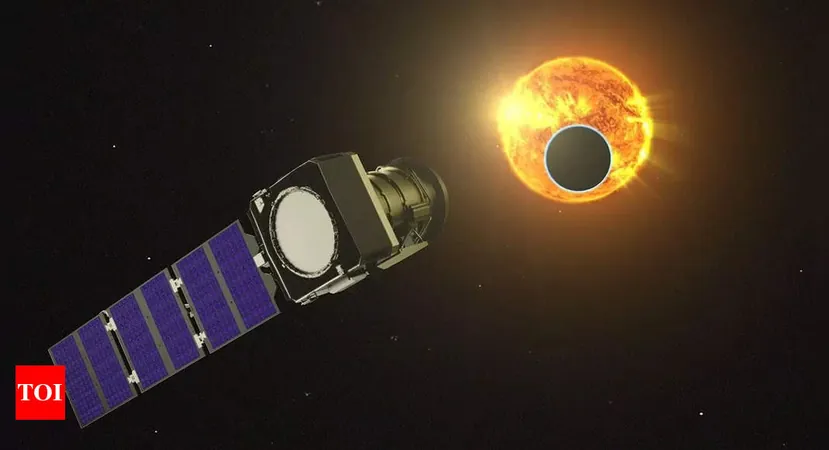
NASA’s Pandora Mission Ramps Up for Fall Launch: What You Need to Know!
2025-01-16
Author: Li
Introduction
NASA is making significant strides toward the launch of its groundbreaking Pandora mission, with the recent completion of the spacecraft bus, a pivotal component that will enable the ambitious goals of the project. Led by the University of Arizona, this mission aims to investigate the atmospheres of at least 20 exoplanets, complementing cutting-edge observations from the James Webb Space Telescope (JWST).
Recent Milestones
During a press briefing at the 245th Meeting of the American Astronomical Society in Maryland on January 16, team members celebrated this crucial milestone, underscoring their continued momentum towards a fall launch. The spacecraft bus is integral, as it provides the essential structure, power, and operational systems that will guide Pandora's functions.
"This marks a huge milestone for us and keeps us firmly on schedule for our upcoming launch," remarked Elisa Quintana, the principal investigator at NASA's Goddard Space Flight Center in Greenbelt, Maryland. "The bus not only houses our scientific instruments but also handles navigation and communication with Earth—essentially being the brains of the spacecraft."
Unique Approach
Pandora is unique in its approach as a compact satellite designed specifically to delve into the atmospheric conditions of distant worlds, primarily focusing on hazes, clouds, and signs of water. This mission promises to reshape our understanding of exoplanets and will significantly enhance the interpretative power of data from both JWST and future endeavors exploring habitable realms.
While Pandora may not match the sensitivity of JWST, its design allows for longer observation periods of the stars that these exoplanets orbit. According to Daniel Apai, a co-investigator and professor of astronomy at the University of Arizona, this capability is vital for deciphering the signals from both stars and their accompanying planets.
Observational Goals
Astronomical observations of exoplanetary atmospheres occur during a transit event, when a planet passes in front of its host star from our perspective on Earth. Apai recalls a challenge identified by a former student, Benjamin Rackham, regarding the interference of stellar light during these observations. Pandora is designed specifically to circumvent this issue, vastly improving our ability to analyze potential life-hosting atmospheres.
Mission Specifications
Equipped with a sophisticated 45-cm wide all-aluminum telescope, co-developed by Lawrence Livermore National Laboratory and Corning Specialty Materials, Pandora will conduct sustained observations, studying each of its 20 target exoplanets at least ten times over the course of its year-long mission.
Operational Readiness
Amidst the preparations, Karl Harshman, who leads the Mission Operations Team at the University of Arizona's Space Institute, expressed enthusiasm for the team's collective effort, noting, "We're eager to have our Mission Operations Center fully operational by launch and ready to receive our scientific data. Recently, we performed a successful communication test with our antenna system, ensuring we can transmit commands to Pandora and receive vital telemetry."
Conclusion
The launch of NASA’s Pandora mission not only represents several years of development but also marks a leap forward in our quest to unravel the mysteries of the cosmos. With an emphasis on continuous observation and data collection, Pandora promises to push the boundaries of our understanding of celestial bodies, leading us closer to finding potentially habitable worlds beyond our solar system.
Stay tuned for more updates on this revolutionary mission!
 Brasil (PT)
Brasil (PT)
 Canada (EN)
Canada (EN)
 Chile (ES)
Chile (ES)
 Česko (CS)
Česko (CS)
 대한민국 (KO)
대한민국 (KO)
 España (ES)
España (ES)
 France (FR)
France (FR)
 Hong Kong (EN)
Hong Kong (EN)
 Italia (IT)
Italia (IT)
 日本 (JA)
日本 (JA)
 Magyarország (HU)
Magyarország (HU)
 Norge (NO)
Norge (NO)
 Polska (PL)
Polska (PL)
 Schweiz (DE)
Schweiz (DE)
 Singapore (EN)
Singapore (EN)
 Sverige (SV)
Sverige (SV)
 Suomi (FI)
Suomi (FI)
 Türkiye (TR)
Türkiye (TR)
 الإمارات العربية المتحدة (AR)
الإمارات العربية المتحدة (AR)